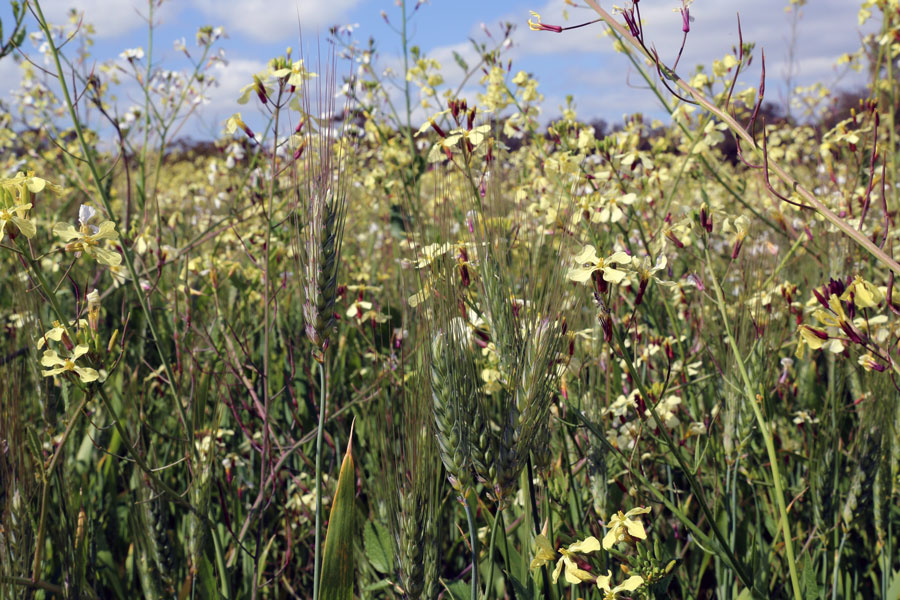Key points
- Wild radish has evolved resistance to multiple herbicide groups due to overuse of herbicides
- Recent studies have shown wild radish is evading harvest weed seed control by shedding seeds early and growing in a more pendulous form, locating pods below harvest cutting height
- It is essential to incorporate more diverse weed control methods, especially those at harvest time
Of all the weeds in Australian farming systems, wild radish (Raphanus raphanistrum L.) is one of the most problematic, but options are available to manage it.
Wild radish is rated second only to annual ryegrass as the most economically damaging weed species. It competes aggressively for water, nutrients and light.
Emphasis has always been on diversifying control methods, such as herbicides, at the start of the growing season. But herbicide over-reliance has resulted in wild radish populations evolving resistance to groups 2, 4, 5, 6, 9, 12, and 27.
To control herbicide-resistant wild radish, integrated weed management methods have been developed, including harvest weed seed control (HWSC).
It was pioneered 30 years ago in Western Australia and has proven highly effective. However, there have been reports of wild radish evading HWSC.
In response, researchers have probed changes in wild radish ecology and say it is now imperative to introduce greater diversity into harvest weed control.
Dr Michael Ashworth and his team from the Australian Herbicide Resistance Initiative (AHRI) at the University of Western Australia, with GRDC support, have been monitoring changes in wild radish in response to weed control methods.
Is earlier flowering to blame?
With researchers thinking a shift in flowering time likely to be the problem, they set out to investigate.
Drawing on the expertise of Dr Gayle Somerville and Dr Hugh Beckie, Dr Ashworth configured the SOMER (Spatial Orientated Modelling of Evolutionary Resistance) model for wild radish.
The goal was to create a genetic model to simulate changes in wild radish flowering, speculating that these changes could help the plant evade HWSC.
Dr Ashworth says that by configuring the SOMER model for wild radish flowering time genetics, the team can simulate and predict how external weed control influences flowering time without waiting for it to happen in the paddock.
After setting up the model, Dr Somerville and Dr Ashworth studied how the model could be applied in paddock conditions.
Interestingly, the modelling showed that despite significant flowering time shifts in recurrent selection studies, HWSC only shortened wild radish flowering time by 12 days. Accordingly, flowering time shifts are not likely to be the problem the researchers first thought.

Wild radish in wheat. Photo: Jon Kerr
Persistent patch
Another study, led by Dr Ashworth and Associate Professor Ken Flower, shifted the focus to a problem patch of wild radish in a grower’s paddock, which had persisted despite more than 20 years of HWSC.
They compared seeds shed to the soil before harvest with seeds from neighbouring wheat paddocks and roadside sites without HWSC. They found that 86 per cent of the persistent population’s radish pods were shed before wheat harvest maturity.
The wild radish seed progeny (the second generation) was then compared in a common garden study at UWA’s Shenton Park facility, which was free from crop competition, weeds, pests and maternal effects.
Compared with the control plants, 60 per cent of the persistent wild radish population shed pods early. As expected, flowering time was not a significant factor in early pod shedding.
The wild radish plants that escaped HWSC grew more pendulous (drooping). Pods were below the harvest cutting height, aiding HWSC evasion.
What to do?
Dr Ashworth says evolution dictates that any trait that enhances survival will be selected. This means that we must identify those traits that give an ecological advantage and design weed control efforts that will work against them.
“Given this new information, we need to up the ante and add more diversity of control methods at harvest or earlier,” he says.
“Wild radish also needs a certain amount of time to mature seed before it’s ready to be shed from the plant.”
He says this means early emerging wild radish plants will likely be candidates for early seed shedding. Accordingly, he says it is imperative to control all the early emerging plants with effective herbicide use to limit the chance of seed shedding before HWSC.
Dr Ashworth suggests monitoring weeds and noting any changes in their life cycles. This can be done by comparing the same weeds in other paddocks or along boundaries and roadsides.
Also, he says a comprehensive review of integrated weed management approaches being used to control wild radish is worthwhile. A good reference is the diverse approach promoted through WeedSmart’s Big 6. “Resistant weeds occur in distinct patches,” Dr Ashworth says.
Weed mapping
To address this, GRDC has invested in a national project led by AHRI to harness modern machinery’s data and software capabilities and weed mapping technologies to more effectively target weeds and their seedbanks.
The project aims to integrate the ability to monitor and strategically target weeds into routine farm operations using precision agriculture capabilities. This approach could reduce herbicide dependency, lower input costs, and slow the development of herbicide resistance through diversification.
More information: Mike Ashworth, mike.ashworth@uwa.edu.au
Somerville GJ, Ashworth MB and Beckie HJ. Adaptations in wild radish (Raphanus raphanistrum) flowering time, Part 1: Individual-based modelling of a polgenic trait. Weed Science, 72(2), March 2024, pp.137–142.
Somerville GJ and Ashworth MB. Adaptations in wild radish (Raphanus raphanistrum) flowering time, Part 2: Harvest weed seed control shortens flowering by 12 days. Weed Science, 72(2), March 2024, pp.143–150.
Ashworth M, Rocha RL, Baxter S and Flower K. Early silique-shedding wild radish (Raphanus raphanistrum L.) phenotypes persist in a long-term harvest weed seed control managed field in Western Australia. Pest Management Science, 80(7), July 2024, pp.3470–3477.

























































